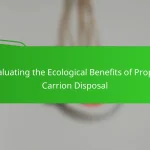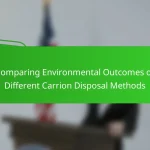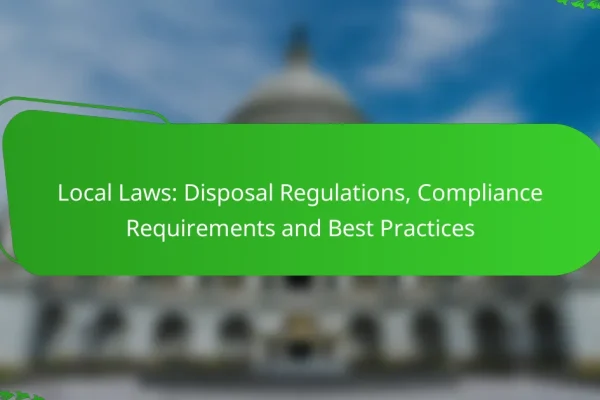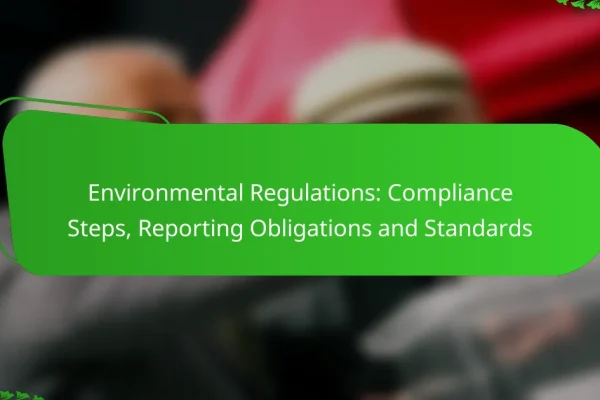What are the legal requirements for carrion management in the United States?
In the United States, legal requirements for carrion management vary by federal, state, and local regulations. Proper disposal and management practices are essential to prevent public health risks and environmental hazards.
Federal regulations
At the federal level, the Environmental Protection Agency (EPA) oversees regulations that may impact carrion management, particularly concerning waste disposal and environmental protection. The Resource Conservation and Recovery Act (RCRA) governs hazardous waste management, which can include certain types of animal carcasses if they are deemed hazardous.
Additionally, the USDA’s Animal and Plant Health Inspection Service (APHIS) provides guidelines for the disposal of livestock carcasses to prevent disease spread. Compliance with these federal regulations is crucial for any entity involved in carrion management.
State-specific laws
Each state has its own laws regarding carrion management, which can include specific methods for disposal, reporting requirements, and permits. For instance, some states may require burial, incineration, or rendering, while others may allow composting as an acceptable method.
It is important to consult state wildlife and agriculture departments for specific regulations, as penalties for non-compliance can vary significantly. States may also have different requirements based on the type of animal, such as livestock versus wildlife.
Local ordinances
Local governments often implement ordinances that further regulate carrion management practices. These can include zoning laws that dictate where carcasses can be disposed of and specific guidelines for handling dead animals in urban versus rural settings.
Engaging with local health departments can provide clarity on any additional requirements or best practices. Local ordinances may also address public nuisance concerns, which can arise from improper disposal methods.
How to comply with environmental regulations in carrion disposal?
Complying with environmental regulations in carrion disposal involves understanding and following specific guidelines set by local and federal authorities. Proper disposal methods not only protect public health but also minimize environmental impact.
Environmental Protection Agency guidelines
The Environmental Protection Agency (EPA) provides comprehensive guidelines for the disposal of carrion to ensure environmental safety. These guidelines typically emphasize methods that prevent contamination of soil and water resources, such as incineration or burial in designated areas.
Facilities handling carrion must adhere to best management practices, which include maintaining records of disposal methods and ensuring that all personnel are trained in proper procedures. Regular inspections may be required to ensure compliance with these guidelines.
State environmental agency protocols
State environmental agencies have their own protocols that may vary from one state to another. These protocols often include specific requirements for reporting and documenting carrion disposal activities, as well as permits for certain disposal methods.
It is essential to consult your state’s environmental agency for detailed regulations, as they may include restrictions on disposal sites or mandates for using licensed disposal facilities. Failure to comply with these state-specific regulations can result in fines or legal action.
What are the liability issues in carrion management?
Liability issues in carrion management primarily revolve around negligence, property damage, and public health concerns. Understanding these aspects is crucial for individuals and organizations involved in the handling of animal remains to mitigate legal risks.
Negligence claims
Negligence claims can arise if a party fails to take reasonable care in managing carrion, leading to harm or damage. For instance, if a company neglects to properly dispose of animal carcasses, resulting in environmental contamination or health risks, they may be held liable. It is essential to follow local regulations and best practices to minimize the risk of such claims.
To avoid negligence claims, ensure that carrion is disposed of in accordance with applicable laws and guidelines. Regular training for staff on proper handling techniques can also help reduce liability risks.
Property damage liability
Property damage liability occurs when the improper management of carrion leads to damage to another person’s property. For example, if decaying animal remains attract pests that damage neighboring properties, the responsible party may face claims for compensation. Maintaining cleanliness and proper disposal methods can help prevent these situations.
Consider conducting regular inspections of the disposal area to identify and address potential issues before they escalate. Keeping detailed records of disposal practices can also serve as evidence of compliance in case of disputes.
Public health concerns
Public health concerns are significant in carrion management, as improperly handled remains can pose risks of disease transmission. Pathogens from decaying carcasses can contaminate soil and water sources, leading to broader health implications for communities. Compliance with health regulations is vital to safeguard public well-being.
Implementing strict hygiene protocols and timely disposal of carrion can mitigate health risks. Engaging with local health authorities for guidance on best practices can further enhance safety measures and reduce liability.
What are the best practices for carrion management?
The best practices for carrion management involve safe handling, proper disposal methods, and thorough documentation. These practices ensure compliance with legal regulations and minimize health risks associated with decomposing animals.
Safe handling procedures
When managing carrion, always wear appropriate personal protective equipment (PPE) such as gloves, masks, and goggles. This minimizes exposure to pathogens and contaminants. Use tools like shovels or tongs to avoid direct contact with the carcass.
Ensure that you are aware of local regulations regarding the handling of dead animals. Some jurisdictions may require specific training or certification for personnel involved in carrion management.
Disposal methods
Common disposal methods for carrion include burial, incineration, and composting. Burial should be done at a depth of at least 1 meter to prevent scavenging and contamination of groundwater. Incineration is effective but may require permits and adherence to air quality regulations.
Composting is an environmentally friendly option that involves mixing carrion with carbon-rich materials. This method can take several months but results in nutrient-rich soil. Always check local guidelines for acceptable disposal methods.
Documentation and reporting
Accurate documentation is crucial in carrion management. Record details such as the species, location, date of discovery, and disposal method used. This information is essential for compliance and tracking potential disease outbreaks.
Report any unusual findings, such as signs of disease or large numbers of carcasses, to local wildlife authorities. Timely reporting helps in monitoring public health and environmental safety.
How to choose a carrion management service?
Selecting a carrion management service involves evaluating several key factors to ensure compliance and effectiveness. Focus on the service’s licensing, experience, and costs to make an informed decision.
Licensing and certifications
Ensure that the carrion management service holds the necessary licenses and certifications required by local regulations. This may include permits for waste disposal and adherence to environmental standards.
Check if the service is certified by recognized organizations, which can indicate a commitment to quality and safety. For example, certifications from environmental agencies can provide assurance of compliance with best practices.
Experience and reputation
Assess the experience of the carrion management service by looking at their track record and the number of years they have been operating. A well-established company is likely to have encountered various scenarios and can handle unexpected challenges effectively.
Research customer reviews and testimonials to gauge the service’s reputation. Positive feedback from previous clients can be a strong indicator of reliability and quality of service.
Cost considerations
When evaluating costs, consider the range of services offered and how they align with your needs. Prices can vary significantly based on factors such as the type of carrion, volume, and specific requirements for disposal.
Request quotes from multiple providers to compare costs effectively. Be cautious of unusually low prices, as they may indicate subpar service or hidden fees. Aim for a balance between cost and quality to ensure you receive satisfactory service.
What are the emerging trends in carrion management legislation?
Emerging trends in carrion management legislation focus on stricter regulations and innovative practices aimed at sustainable disposal and environmental protection. These trends are driven by increasing awareness of public health risks and ecological impacts associated with improper carrion handling.
Increased Regulation on Disposal Methods
Many regions are implementing stricter regulations regarding the disposal of animal remains. This includes guidelines on incineration, composting, and burial practices to ensure that they meet environmental standards. For instance, some jurisdictions now require permits for certain disposal methods to minimize contamination risks.
Organizations involved in carrion management must stay informed about local regulations, which can vary significantly. Regular training and updates on compliance can help prevent legal issues and promote best practices.
Adoption of Sustainable Practices
Sustainable practices in carrion management are gaining traction, with a focus on reducing waste and promoting recycling of animal remains. Techniques such as anaerobic digestion and biochar production are being explored as eco-friendly alternatives to traditional disposal methods.
Implementing these sustainable practices can not only comply with emerging legislation but also enhance an organization’s reputation. For example, facilities that utilize composting can turn waste into valuable soil amendments, benefiting local agriculture.
Technological Innovations in Monitoring
Technological advancements are playing a crucial role in carrion management, particularly in monitoring and tracking disposal processes. Innovations such as GPS tracking and remote sensors can help ensure compliance with regulations and improve operational efficiency.
Investing in technology can provide organizations with real-time data on the status of carrion disposal, helping to identify potential issues before they escalate. This proactive approach can lead to better resource management and adherence to legal requirements.










